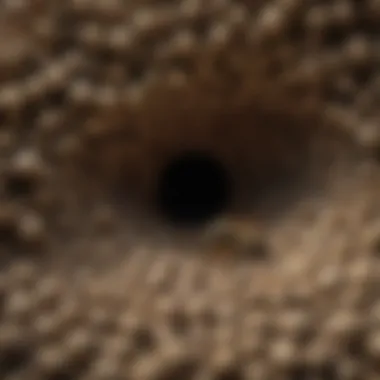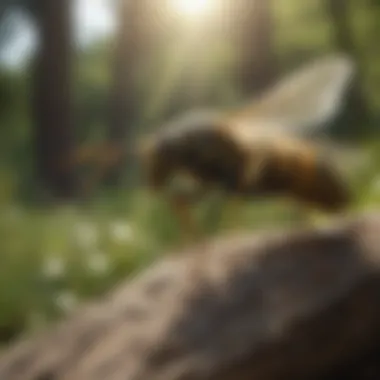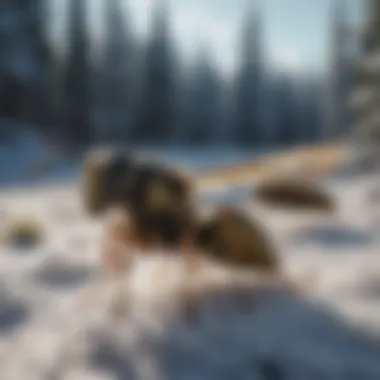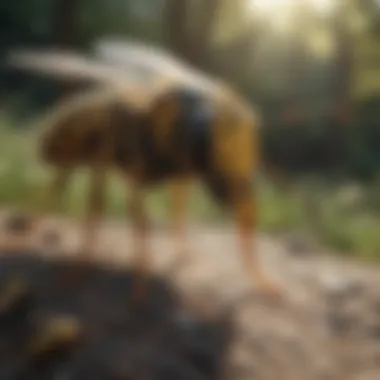Effective Strategies for Winter Wasp Control


Understanding the Pest
Wasps can pose a significant concern for homeowners, even in the winter months. To effectively manage them, it’s crucial to have a thorough understanding of these insects. Knowledge about their identification and life cycle is fundamental to implementing successful control strategies.
Identification
Identifying wasps correctly is essential. Various species exist, but the common wasps found in many areas include the European wasp and the yellow jacket. European wasps have a distinct appearance with a body marked by yellow and black stripes. They are usually larger than bees and possess smooth bodies.
On the other hand, yellow jackets have a more robust body structure and often exhibit a more aggressive behavior. Their nests are usually located in hollows, like inside wall cavities or underground. Proper identification allows homeowners to determine the right strategies for removal and prevention.
Life Cycle
The life cycle of wasps is fascinating and critical to consider in winter eradication efforts. Wasps generally undergo a complete metamorphosis, which consists of four stages: egg, larva, pupa, and adult. Key points regarding their life cycle include:
- Egg Stage: Fertilized queens lay eggs in late summer or early fall, which then develop into female workers.
- Larva Stage: Larvae are fed by the adult wasps, primarily a protein-rich diet, which allows them to grow rapidly.
- Pupa Stage: After several days, larvae pupate, forming a cocoon where they undergo transformation.
- Adult Stage: Once fully developed, wasps emerge as adults ready to continue the cycle.
Many wasps die in winter; however, fertilized queens hibernate in safe spots. This aspect of their life cycle reveals the strategic timing for addressing wasp populations.
Pest Prevention Strategies
Preventing wasps from nesting in the first place can save homeowners much hassle during winter. Implementing effective prevention strategies is essential. Two primary approaches include environment modification and physical barriers.
Environment Modification
Making simple adjustments in the surroundings significantly reduces the likelihood of wasp infestations. Consider these key measures:
- Food Storage: Ensure that food waste is properly sealed. Many wasps are attracted to sugary and protein-rich foods.
- Close Off Entry Points: Seal any cracks or gaps in your home’s exterior walls.
- Remove Nests: Early winter is the best time to remove old nests, as they are likely deserted.
Physical Barriers
Physical barriers can also serve to keep wasps at bay during the colder months. Below are some effective strategies:
- Screens: Install screens on windows and vents to prevent wasps from entering your home.
- Trap Placement: Set out commercial wasp traps or homemade traps near known problem areas before the cold sets in.
- Decoys: Hang fake nests to deter real wasps; they tend to avoid areas with existing colonies.
Control Methods
Despite preventive actions, managing wasps may still be necessary. Various control methods can be employed, ranging from chemical control to biological control.
Chemical Control
Chemical control should be a last resort due to its potential impact on the environment. If necessary, use insecticides labeled for wasp control. Ensure to carefully follow the usage instructions. Target nests during dusk or dawn when wasps are less active. Always prioritize safety and wear appropriate protective gear.
Biological Control
An eco-friendly approach involves biological control methods. Encouraging natural predators can help regulate wasp populations. Birds, certain spiders, and parasitic wasps play a role in controlling wasp numbers. Homeowners can also introduce native plants that attract beneficial insects to create a balanced ecosystem.
It's vital to understand that while wasps can be bothersome, they also play critical roles in the ecosystem, including pollination and pest control.
End
In summary, addressing wasps during winter involves understanding their nature, implementing prevention strategies, and utilizing effective control methods. By recognizing their biological patterns and behaviors, homeowners can maintain a comfortable living environment without resorting to harmful interventions. Keeping homes pest-free is an ongoing process, but informed decisions can lead to effective outcomes.
Understanding Wasp Behavior in Winter
Understanding the behavior of wasps during the winter months is crucial for effective pest management. Winter presents unique challenges and opportunities for homeowners, as many wasp species exhibit specific behaviors that can lead to increased indoor activity. By comprehending these patterns, one can prevent infestations and maintain a safer living environment.


The Biological Lifecycle of Wasps
Wasps go through distinct stages in their lifecycle: egg, larva, pupa, and adult. Each stage plays a role in the population dynamics of wasps during winter. In colder climates, many species enter a dormant state as adults, with the queen wasp being the most notable example. In autumn, fertilized queens find sheltered locations to hibernate. Understanding this lifecycle is essential because it informs strategies for effective elimination and prevention. Where demand for food dwindles, wasps are less likely to be active, which means residential environments can often remain free from infestations during this period.
Habitual Patterns in Cold Weather
In the winter, wasps are not as active as they are during warmer months. During cold weather, they tend to stay in their nests, often in tree crevices, attics, or other sheltered areas. They may become lethargic, making them less threatening. However, this does not mean they are entirely inactive. Occasionally, when the weather becomes unseasonably warm, wasps may emerge, creating potential risks for homeowners. Being aware of these patterns allows for timely action to seal entry points in homes and reduce any possible encounters.
Identifying Wasp Species in Your Area
Different wasp species exhibit varying behaviors and preferences for nesting sites. It is vital to properly identify the species present in your area to develop targeted management strategies. Common species include the yellow jacket, paper wasp, and hornets. Each has unique characteristics and nesting habits. For instance, yellow jackets often nest in the ground, while paper wasps prefer to build their homes in protected eaves or tree branches. Resources like Wikipedia and Britannica provide further insights into the differences between wasp species, aiding in accurate identification.
"Understanding the specific wasp species in your area can significantly influence the approach to managing their populations during the winter months." - Pest Control Expert
Signs of Wasp Activity Indoors
Recognizing signs of wasp activity indoors is crucial in the cold months. Wasps are typically more active in the warmer seasons but can take shelter in homes during winter. Identifying their presence early can prevent larger infestations. Indicators may not always be obvious, so understanding visual and auditory signs can be key for effective intervention.
Visual Indicators of Infestations
Visual cues are often the first signs of wasp activity that homeowners can notice. These signs might include:
- Nests: Look in attics, garages, and any hidden spaces for nests. Some species prefer to build nests in sheltered places. Wasps can construct nests out of chewed wood fibers, forming a papery structure.
- Damage: Inspect wooden structures for chew marks. Wasps may damage wood to make their nests. Small holes in the wood can indicate this activity.
- Carcasses: Finding dead wasps near windows or doors can indicate an infestation. These may have entered and become trapped.
Understanding these visual indicators helps in locating the areas where wasps might nest or enter. Early action can then be taken to manage these signs effectively.
Auditory Cues of Wasp Presence
Auditory signs can also provide insight into wasp activity. Homeowners should be aware of:
- Buzzing Sounds: A distinct buzzing can signal wasp presence. This noise often intensifies when wasps are near their nests or entering through openings.
- Movement Sounds: Sounds of movement within walls or ceilings might suggest wasps are nesting. These may be soft scraping sounds caused by wasps creating their nests.
Paying attention to these auditory signals can augment visual inspections. Combining both types of cues allows for a thorough evaluation of potential wasp issues indoors.
"Early detection is a crucial factor in managing wasp problems effectively. Recognizing the signs can save homeowners from larger infestations later on."
In summary, understanding signs of wasp activity indoors prepares homeowners to address potential issues before they escalate. Regular inspections and awareness of these indicators can lead to a healthier, pest-free environment.
Preventive Measures for Winter Wasp Control
Effective wasp control in winter months requires a proactive approach. Preventive measures are essential to reduce the likelihood of wasps invading indoor spaces. Understanding the nature of wasps and addressing potential attractants creates a safer home environment. Implementing these measures can prevent infestations and ensure comfort throughout the cold season.
Sealing Entry Points
Assessing Areas of Vulnerability
Assessing areas of vulnerability involves identifying various entry points in and around the home where wasps could gain access. Common areas include gaps in doors, windows, and any spaces around insulation. Through this assessment, homeowners are able to understand where they need to focus their preventive efforts. This specific aspect plays a crucial role in maintaining a pest-free home.
The key characteristic of assessing these vulnerable areas is its thoroughness. A detailed inspection can pinpoint even the smallest openings, which are often overlooked. This method is beneficial for the article’s goal of identifying effective strategies against wasps. The unique feature here is the proactive identification of risks. Noticing these issues early can prevent further complications related to wasp infestations. However, the task requires attention to detail and may take considerable time, which some homeowners might find challenging.
Using Effective Sealing Materials
Using effective sealing materials is fundamental in fortifying entry points identified during the assessment. This involves employing commercial-grade caulking, weather stripping, and specific materials designed to resist pests. The contribution of this practice is significant because it directly hinders wasps' ability to enter.
The key characteristic of sealing materials is their durability. A strong seal can last through multiple seasons and is a popular choice for homeowners looking to protect their space. The unique feature of these materials is their dual purpose; they not only keep pests out but also improve energy efficiency. These materials can be an investment, which may be seen as a disadvantage, due to the initial cost involved. Yet, the long-term benefits often outweigh this concern, making it a worthwhile preventive strategy.


Removing Potential Food Sources
Securing Food Waste
Securing food waste is a critical action in wasp control. Wasps are attracted to food residue and waste, which can invite them towards your home, especially during winter. Taking steps to secure waste involves using tightly sealed bins and ensuring that food scraps are disposed of correctly.
The key characteristic of this practice is its simplicity. It doesn't require professional intervention and can be implemented immediately. Therefore, it is a beneficial choice in the context of this article. The unique feature is that it reduces not only wasp attraction but also other pests as well. The downside may include the need for consistent effort to maintain cleanliness, as neglecting these practices can quickly negate the benefits.
Cleaning Up Outdoor Feeding Areas
Cleaning up outdoor feeding areas entails removing any decaying fruit or pet food that might attract wasps. Gardens or patios that are not kept clean can become hotspots for these pests. This action contributes significantly to the overall aim of controlling wasps in winter.
The key characteristic of cleaning these areas is the focus on prevention rather than response. By adopting this mindset, it helps in curbing potential infestations before they start. A beneficial point here is that maintaining cleanliness also enhances the aesthetic of outdoor spaces. The unique feature of this practice is its universal application, as it benefits various aspects of home care. A drawback may be the need for frequent maintenance, which could be a concern for busy homeowners.
Effective Wasp Elimination Techniques
Understanding effective wasp elimination techniques is crucial for maintaining a pest-free home during the winter months. Wasps can seek shelter indoors, particularly in garages and attics. Using methodical strategies can help prevent their presence. These techniques enhance safety, minimize risks associated with wasp stings, and ensure that living spaces remain comfortable for families.
Chemical Control Options
Types of Insecticides
Chemical control options include a variety of insecticides designed for wasp management. Pyrethroids are a common choice due to their quick action. They affect the nervous system of insects, leading to rapid immobilization and death. This speed is essential when addressing immediate concerns, especially if an infestation seems imminent.
Another notable category is residual insecticides, which continue to work after application. They can kill wasps that come into contact with treated surfaces days or weeks later. This feature is beneficial for ongoing infestations. However, caution is necessary; users should be aware of potential environmental impacts and toxicity to non-target species.
Application Methods and Safety Precautions
Application methods vary and should be executed with care. Spray insecticides typically come in pressurized canisters, allowing for direct targeting of nests or visible wasp activity. It is advantageous to apply during evening or early morning when wasps are less active. However, specific protective gear, such as gloves and masks, is recommended to minimize direct exposure and potential allergic reactions.
When using these products, it is important to follow all instructions on labels. Missing steps can lead to ineffective treatment and increased risk. Additionally, avoid mixing different chemicals as this could result in hazardous reactions.
Natural Repellents and Solutions
Essential Oils and Their Efficacy
Natural repellents, like essential oils, offer a safer alternative to chemical insecticides. Oils such as peppermint and clove have been shown to repel wasps effectively. The strong scent both confuses and deters wasps, reducing the likelihood of their presence. This approach is appealing for environmentally conscious individuals who wish to limit chemical exposure in their homes.
However, while essential oils are beneficial, they may require more frequent application compared to chemical methods. Furthermore, their effectiveness can depend on the concentration used and the specific situation, leading to variable results.
Homemade Wasp Traps
Homemade wasp traps can effectively capture and reduce wasp populations. These traps often utilize simple ingredients such as sugar water or vinegar to attract wasps. By placing these traps near known entry points, homeowners can decrease the chances of wasps roaming inside.
Creating a homemade trap is straightforward. A common method includes cutting the top off a plastic bottle, filling the bottom with a bait, and inverting the top to create a funnel. This design reduces the chance of escape. Nonetheless, while homemade traps can lessen the number of wasps, they should be used as part of a comprehensive control strategy for the best results.
Post-Elimination Monitoring
Post-elimination monitoring plays a critical role in managing wasps effectively during the winter months. After implementing various strategies to eliminate these pests, it is essential to observe and assess the outcomes. This step ensures that the methods used were successful and helps in identifying any additional infestations. Monitoring allows homeowners to maintain a pest-free environment and reaffirm their efforts against wasps.
The benefits of post-elimination monitoring are substantial. It assists in understanding the effectiveness of chosen strategies and can reveal if modifications are necessary for better results. Furthermore, closely watching your surroundings can help to catch any potential re-infestations early, which is crucial for swift response.
Establishing a Monitoring Routine
Creating a routine for monitoring is vital in controlling wasp populations. Choose specific times during the week to inspect common areas where wasps may reappear. A good starting point may be early mornings or late afternoons when wasp activity tends to be low. Regular checks should include:


- Inspecting entry points around windows, doors, and vents.
- Looking for any new nests forming in sheltered areas.
- Evaluating your yard for signs of wasp behavior like gathering or increased flying activity.
Using a journal to document your observations can be an effective way to keep track of your findings. This log can highlight patterns over time, aiding in understanding whether any particular area is prone to wasp activity.
Adjusting Strategies Based on Findings
If monitoring indicates ongoing wasp presence, adjustments to the elimination strategies may be necessary. First, review the steps previously undertaken. Have all entry points been adequately sealed? Are there any food sources that might still attract wasps? Based on findings, you can consider:
- Reinforcing sealing around openings or adding new barriers.
- Re-evaluating food waste management practices if these are identified as attractants.
- Exploring alternative or additional control methods such as natural repellents.
This adaptive approach ensures that your control methods evolve based on actual circumstances, allowing for a targeted and efficient response to ongoing wasp challenges.
"Continuous monitoring and adjustment are key to successful pest management, as static measures might not suffice in changing environments."
When to Consult Professionals
Managing wasps can be a challenging task, especially during winter months when their presence might be unnoticed yet detrimental. Recognizing when to seek help from a professional pest control expert is crucial. Professionals possess the knowledge and tools necessary to address wasp infestations effectively. They can offer a comprehensive assessment, ensuring that all potential threats are managed thoroughly.
When considering professional assistance, it is important to evaluate the scale of the infestation. Larger problems typically require an expert’s intervention, as the risks involved might exceed the average homeowner's ability to manage.
Recognizing Scale of Infestation
The first step in understanding the need for professional help is recognizing the scale of the infestation. Signs that you may have a significant wasp problem include frequent sightings of wasps indoors, numerous wasp decomposed remains found in or around the home, and visible nests. If these signs are present, it can indicate that the wasp infestation is beyond a small, easily manageable number.
A single wasp does not usually mean immediate concern; however, multiple wasps buzzing around a specific location or consistent entry points to the home can signal a more serious situation. Ignoring these signs can lead to increased numbers, making it difficult to eliminate them effectively.
Selecting a Pest Control Expert
Choosing the right pest control expert can make a substantial difference in managing wasp infestations.
Identifying Credentials and Experience
One of the crucial aspects in selecting a pest control expert is their credentials and experience. Look for professionals who are licensed and have a solid background in pest management. Their experience in dealing with wasp infestations specifically can enhance the effectiveness of their services. A good pest control agent will not only provide a solution but will also educate the homeowner on maintaining a pest-free environment.
The key characteristic to note here is the reputation of the expert. A well-reviewed service usually indicates reliability.
By employing qualified experts, you increase the likelihood of a thorough elimination process leading to long-term solutions.
Evaluating Eco-Friendly Practices
Given the increased emphasis on sustainability, evaluating the eco-friendly practices of a pest control service is essential. Pest control experts should provide methods that minimize harm to the environment. Using less harmful substances can safeguard beneficial insects, plants, and overall ecosystem balance.
This characteristic is significant because it aligns with the growing awareness towards minimizing our ecological footprint. Choosing a professional that emphasizes eco-friendly practices reflects the values of many homeowners today.
When selecting a pest control expert, inquire directly about their approaches, ensuring they utilize sustainable solutions whenever possible. Identifying a company that prioritizes eco-friendly methods often leads to advantageous long-term results, keeping your home safe while respecting nature.
Closure
The conclusion of this article emphasizes the critical importance of effectively managing wasps during the winter season. While wasps are typically less active in colder months, any lingering populations can become problematic as they seek shelter inside homes. Understanding this dynamic can aid homeowners in implementing successful control strategies.
Summarizing Key Points
In summary, several key points are crucial to remember:
- Wasp behavior during winter is influenced by their biological lifecycle, with late fall and early spring being critical periods for management.
- Preventive measures are essential for minimizing indoor wasp activity. Sealing entry points and removing food sources significantly reduce the likelihood of infestation.
- Effective elimination techniques vary between chemical and natural approaches. Homeowners need to weigh the pros and cons of each based on their comfort levels and environmental considerations.
- Continuous monitoring is vital. Regular checks can inform necessary adjustments in strategies to ensure no new infestations occur.
- Knowing when to consult professionals is crucial. A comprehensive understanding of pest control experts’ qualifications can make a decisive difference in successfully managing a wasp presence.
Encouraging Continuous Vigilance
Encouraging continuous vigilance cannot be overstated. Maintaining a watchful eye on both interior and exterior environments ensures that wasp management efforts yield long-lasting results. Seasonal changes in behavior can affect wasp activity, and staying informed about their patterns can help detect early signs of infestation. Homeowners should remain proactive in following up on preventive measures, including checking for potential entry points and debris that may attract wasps.
By embedding these practices into their routines, homeowners can significantly enhance their chances of enjoying a pest-free environment, thus safeguarding their home and family. In doing so, they not only protect their immediate living space but also contribute to the eco-balance by reducing reliance on harmful pest control methods.







